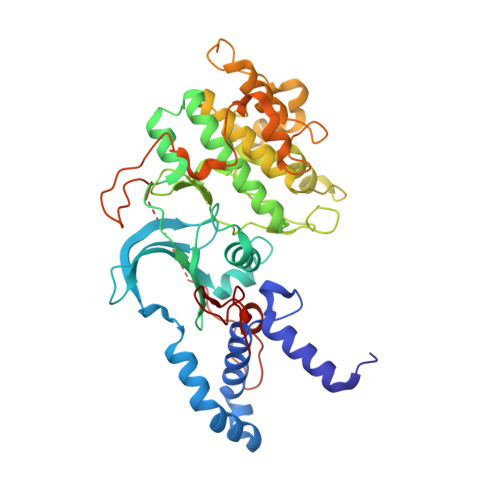Discovery of Potent and Selective MRCK Inhibitors with Therapeutic Effect on Skin Cancer.
Unbekandt, M., Belshaw, S., Bower, J., Clarke, M., Cordes, J., Crighton, D., Croft, D.R., Drysdale, M.J., Garnett, M.J., Gill, K., Gray, C., Greenhalgh, D.A., Hall, J.A.M., Konczal, J., Lilla, S., McArthur, D., McConnell, P., McDonald, L., McGarry, L., McKinnon, H., McMenemy, C., Mezna, M., Morrice, N.A., Munro, J., Naylor, G., Rath, N., Schuttelkopf, A.W., Sime, M., Olson, M.F.(2018) Cancer Res 78: 2096-2114
- PubMed: 29382705
- DOI: https://doi.org/10.1158/0008-5472.CAN-17-2870
- Primary Citation of Related Structures:
5OTE, 5OTF - PubMed Abstract:
The myotonic dystrophy-related Cdc42-binding kinases MRCKα and MRCKβ contribute to the regulation of actin-myosin cytoskeleton organization and dynamics, acting in concert with the Rho-associated coiled-coil kinases ROCK1 and ROCK2. The absence of highly potent and selective MRCK inhibitors has resulted in relatively little knowledge of the potential roles of these kinases in cancer. Here, we report the discovery of the azaindole compounds BDP8900 and BDP9066 as potent and selective MRCK inhibitors that reduce substrate phosphorylation, leading to morphologic changes in cancer cells along with inhibition of their motility and invasive character. In over 750 human cancer cell lines tested, BDP8900 and BDP9066 displayed consistent antiproliferative effects with greatest activity in hematologic cancer cells. Mass spectrometry identified MRCKα S1003 as an autophosphorylation site, enabling development of a phosphorylation-sensitive antibody tool to report on MRCKα status in tumor specimens. In a two-stage chemical carcinogenesis model of murine squamous cell carcinoma, topical treatments reduced MRCKα S1003 autophosphorylation and skin papilloma outgrowth. In parallel work, we validated a phospho-selective antibody with the capability to monitor drug pharmacodynamics. Taken together, our findings establish an important oncogenic role for MRCK in cancer, and they offer an initial preclinical proof of concept for MRCK inhibition as a valid therapeutic strategy. Significance: The development of selective small-molecule inhibitors of the Cdc42-binding MRCK kinases reveals their essential roles in cancer cell viability, migration, and invasive character. Cancer Res; 78(8); 2096-114. ©2018 AACR .
- Molecular Cell Biology Laboratory, Cancer Research UK Beatson Institute, Glasgow, United Kingdom.
Organizational Affiliation:



















